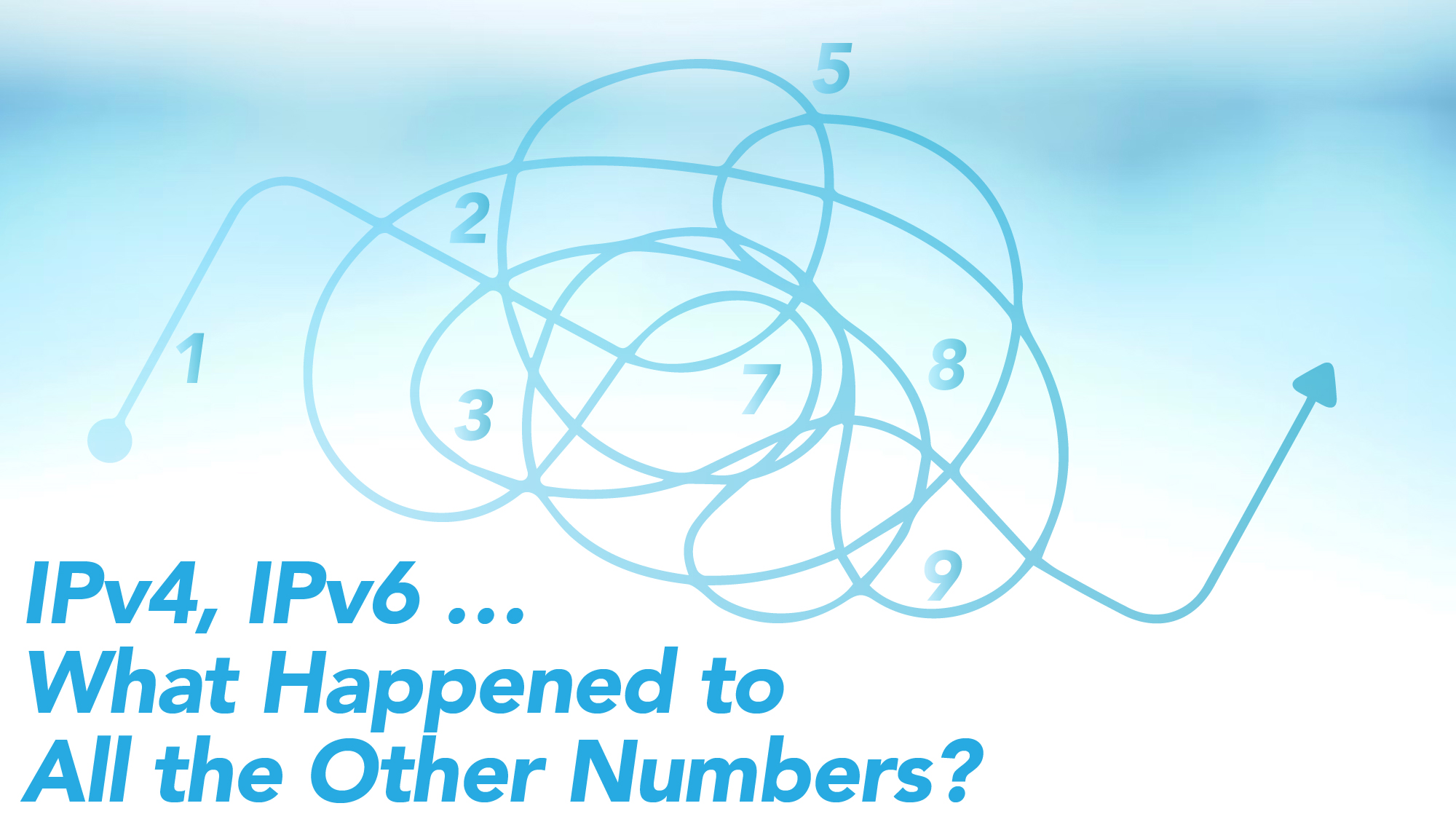
IPv4, IPv6 … What Happened to All the Other Numbers?
All the Possibilities
Discussing migration from IPv4 to IPv6 raises the questions: What about IP versions 0 to 3 and 5? And do versions higher than 6 exist? Before answering those questions, let’s look at the practical possibilities when it comes to version number values.
The version number value is in a 4-bit field in the IP header. Since the values you can make with 4 bits range from 0 to 15, those are the only possible values for an IP version.
Let’s Start at the Very Beginning
As detailed in RFC 1700 and on IANA’s website:
IPv0 was reserved.
IPv1 was unassigned according to RFC 1700, but reserved according to IANA.
IPv2 was unassigned.
IPv3 was unassigned.
Caught in the Middle
IPv5 was not really assigned, but it was understood to be associated with a separate experimental protocol for streaming that saw limited use. In 1979, IEN 119 (Internet Experiment Notes were used instead of RFCs for non-ARPANET developments) defined Internet Stream Protocol (ST), which worked alongside Stream Control Message Protocol (SCMP). RFC 1190 - Experimental Internet Stream Protocol, Version 2 (ST-II) from 1990 and RFC 1819 - Internet Stream Protocol Version 2 (ST2) Protocol Specification - Version ST2+ from 1995 revised ST.
The protocol itself was an experiment for resource reservation that provided Quality of Service (QoS) for multimedia applications that involved real-time communications, including video and voice. The plan was not to replace IPv4 with ST2, but rather have IPv4 for regular packets and ST2 for packets containing real-time data.
When ST/ST2 was encapsulated in IPv4 packets, the Protocol Number field had a value of 5, just like packets encapsulating ICMP contain a value of 1 in the Protocol Number field, packets encapsulating Transmission Control Protocol (TCP) segments contain a value of 6 in the Protocol Number field, and packets that contain User Datagram Protocol (UDP) datagrams contain a value of 17 in the Protocol Number field.
When ST/ST2 was not encapsulated in IPv4 packets, it used the value of 5 in the Version Number field in its own header, but never was thought of or referred to as IPv5. When IPv6 was designed, to avoid any confusion, IPv5 was skipped, and the name of the protocol went to IPv6.
ST2 saw usage for distributed simulations and videoconferencing in the Terrestrial Wideband Network and its replacement, the Defense Simulation Internet. Its design was incorporated into the core technology for voice call transportation and other real-time streams for Canada’s Iris Digital Communications System.
Anything ST related, today, is long obsolete.
Here’s a snippet from RFC 1190:
2.2. Concepts and Terminology
The ST packet header is not constrained to be compatible with the IP packet header, except for the IP Version Number (the first four bits) that is used to distinguish ST packets (IP Version 5) from IP packets (IP Version 4). The ST packets, or protocol data units (PDUs), can be encapsulated in IP either to provide connectivity (possibly with degraded service) across portions of an internet that do not provide support for ST, or to allow access to services such as security that are not provided directly by ST.
ST uses IP Version Number 5.
When encapsulated in IP, ST uses IP Protocol Number 5.
Here’s a snippet from RFC 1819:
0 1 2 3
0 1 2 3 4 5 6 7 8 9 0 1 2 3 4 5 6 7 8 9 0 1 2 3 4 5 6 7 8 9 0 1
+-+-+-+-+-+-+-+-+-+-+-+-+-+-+-+-+-+-+-+-+-+-+-+-+-+-+-+-+-+-+-+-+
| ST=5 | Ver=3 |D| Pri | 0 | TotalBytes |
+-+-+-+-+-+-+-+-+-+-+-+-+-+-+-+-+-+-+-+-+-+-+-+-+-+-+-+-+-+-+-+-+
| HeaderChecksum | UniqueID |
+-+-+-+-+-+-+-+-+-+-+-+-+-+-+-+-+-+-+-+-+-+-+-+-+-+-+-+-+-+-+-+-+
| OriginIPAddress |
+-+-+-+-+-+-+-+-+-+-+-+-+-+-+-+-+-+-+-+-+-+-+-+-+-+-+-+-+-+-+-+-+
Figure 10: ST Header
- ST is the IP Version Number assigned to identify ST packets. The value for ST is 5.
- Ver is the ST Version Number. The value for the current ST2+ version is 3.
The Next Internet
IPv7, TP/IX: The Next Internet, was described in RFC 1475 in 1993 (even before RFC 1883 described IPv6 in 1995). From the introduction:
This memo presents the specification for version 7 of the Internet Protocol, as well as version 7 of the TCP and the user datagram protocol. Version 7 has been designed to address several major problems that have arisen as version 4 has evolved and been deployed, and to make a major step forward in the datagram switching and forwarding architecture of the Internet.
The version number of 7 was chosen by the author of the RFC, R. Ullmann, who mistakenly thought IPv6 was being used for ST-II (which used the same version number of 5 as ST).
IPv7 has been obsoleted.
Pip, Pip, Hooray
IPv8, P Internet Protocol (PIP), was described in RFC 1621 in 1994 (also before IPv6). It had a similar introduction to IPv7’s:
Pip is an internet protocol intended as the replacement for IP version 4. Pip is a general purpose internet protocol, designed to handle all foreseeable internet protocol requirements. This specification describes the routing and addressing architecture for near-term Pip deployment. We say near-term only because Pip is designed with evolution in mind, so other architectures are expected in the future. This document, however, makes no reference to such future architectures (except in that it discusses Pip evolution in general).
IPv8 has been obsoleted.
Three Times Three Is…
IPv9 can refer to one of three different things.
First, TCP and UDP with Bigger Addresses (TUBA), A Simple Proposal for Internet Addressing and Routing, described in RFC 1347 in 1992.
The summary of the RFC follows a similar refrain:
The Internet is approaching a situation in which the current IP address space is no longer adequate for global addressing and routing. This is causing problems including: (i) Internet backbones and regionals are suffering from the need to maintain large amounts of routing information which is growing rapidly in size (approximately doubling each year); (ii) The Internet is running out of IP network numbers to assign. There is an urgent need to develop and deploy an approach to addressing and routing which solves these problems and allows scaling to several orders of magnitude larger than the existing Internet. However, it is necessary for any change to be deployed in an incremental manner, allowing graceful transition from the current Internet without disruption of service. [1]
That IPv9 instance has been obsoleted.
Second, A Historical Perspective on the Usage of IP Version 9, described in RFC 1606 on 1 April 1994, was an … April Fools’ Day joke.
Third, word of a Chinese IPv9 made the rounds in the summer of 2004. The plan with this IPv9 was to connect Internet addressing with Chinese 10-digit telephone numbers, which can be used to navigate the web as well as for use of other protocols like FTP and SSH. The way it works is like a modified DNS server that intercepts domain names containing all numbers, forwarding those requests to their own root servers, and having those root servers resolve the queries to an IPv4 or IPv6 address. All you need to do is to register your telephone number with China. This idea never seemed to gain any steam, and China immediately disowned the IPv9 hype. Network experts from Fudan University in Shanghai had no idea of any such deployment, and it was believed to be one researcher or group trying to promote a 256-bit version of IPv6.
Additional papers or research related to China’s IPv9 were published:
- https://ieeexplore.ieee.org/document/8912062
- https://ieeexplore.ieee.org/document/9239820
- https://worldwide.espacenet.com/patent/search/family/033728148/publication/CN2591884Y?q=pn%3DCN2591884
- https://ieeexplore.ieee.org/document/8912101
- https://link.springer.com/chapter/10.1007%2F978-981-16-2670-8_3
- https://www.exeley.com/international_journal_advanced_network_monitoring_controls/doi/10.21307/ijanmc-2020-005
China’s IPv9 has been abandoned.
And Four Plus Six Is…
IPv10, Internet Protocol version 10 (IPv10), described in an Internet draft in 2017, was in its 13th version in October 2020 and appears to be one person’s attempt at expressing frustration at the lack of IPv6 adoption. The purpose of IPv10 is to allow IPv6 and IPv4 to intercommunicate, and the 10 in IPv10 is the sum of 4+6. Therefore, both IPv4 and IPv6 need to be running on a machine (dual-stacked) for that machine to run IPv10. If that’s the case, why would anyone want to introduce a third protocol and require a machine to be triple-stacked? Also, think of the millions of IPv4-only devices that need to put an IPv4 address in a 128-bit address field.
The same author, Khaled Omar, is responsible for another Internet Draft that contains the following paragraph:
2. Satellite Internet (SI)
SI works by using a space network of satellites that surrounds the whole earth, connected to each others using fiber optic cables, and have coverage areas that covers the whole earth without frequency interference ...
IPv10, from the same author who wants to put wires in outer space, is still listed as unassigned, as the draft never will become anything but a draft.
Finish Out the Category
The remainder of possible Internet Protocol version values exist as follows, as detailed in RFC 1700 and on IANA’s website:
IPv11-14 are unassigned.
IPv15 was reserved.
Any views, positions, statements, or opinions of a guest blog post are those of the author alone and do not represent those of ARIN. ARIN does not guarantee the accuracy, completeness, or validity of any claims or statements, nor shall ARIN be liable for any representations, omissions, or errors contained in a guest blog post.
Recent blogs categorized under: IPv6
GET THE LATEST!
Sign up to receive the latest news about ARIN and the most pressing issues facing the Internet community.
SIGN ME UP →Blog Categories
ARIN Bits • Tips • Updates • Elections • Caribbean • Outreach • Security • RPKI • Public Policy • Guest Post • Grant Program • Fellowship Program • Data Accuracy • IPv6 • Business Case for IPv6 • Internet Governance • Training • IPv4 • Customer Feedback • IRR



